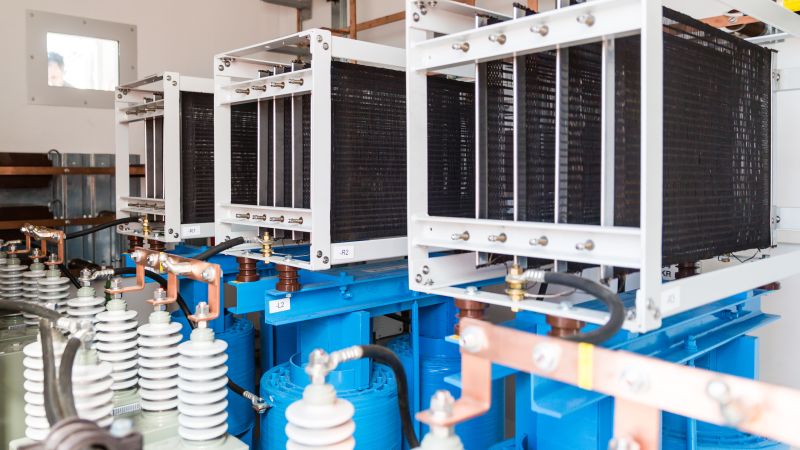Wind turbines are environmentally friendly energy suppliers. But the power they produce can place a strain on electricity grids. At a wind farm in Germany’s Rhineland-Palatinate region, a high-frequency filter system from MR keeps the grid in perfect working order.
The air is clear, the sky is blue, and a soft breeze is blowing across the fields of the Palatine municipality of Offenbach an der Queich. This breeze is enough to set in motion the huge rotor blades of the six wind turbines operated by regional energy supplier EnergieSüdpfalz GmbH & Co. KG. They rotate ceaselessly – and every rotation produces environmentally friendly power. Each year, this amounts to a total of 40 million kilowatt-hours for 13,800 households, and the wind farm has a total output of 15.8 megawatts. There are thousands of power plants just like this one across the globe. But a small concrete structure at the foot of the over one-hundred-meter-high wind turbines turns the Offenbach wind farm into something special: The little building contains the first high-frequency filter system from MR, which ensures disruption-free grids at frequencies up to 9 kHz.
The backstory
This is necessary because, although power from renewable energy sources is environmentally friendly, in contrast to conventional power stations, it is difficult to keep the grid frequency in wind power plants at a stable level. The rotors turn faster or slower depending on the strength of the wind, causing the amount of power generated to vary. In order to balance out these fluctuations, rectifier transformers with what are known as IGBTs (insulated gate bipolar transistors) are brought into play in modern wind power plants. The problem here, however, is that this technology causes harmonics that can be damaging to electricity grids.

A wind farm operator is therefore only allowed to supply its power to the grid if certain limit values are not exceeded. This was exactly the problem that EnergieSüdpfalz and project developer juwi Wind GmbH were faced with: The electricity generated by the wind turbines exceeded the limit values for harmonics at frequencies up to 9 kHz. That being the case, the two partners turned to the Power Quality experts at MR for advice. “Harmonics per se are not unusual and can be dealt with using passive filter systems. We already have many years of experience in this field. But normally we would be dealing with frequency ranges up to 2.5 kHz,” explains Dr. Thomas Schlegel, Head of Engineering in the Power Quality department.
The filter concept
Schlegel and his team accepted the challenge and started on the development of a suitable filter concept. The aim was to drop the harmonic level in the frequency range up to 9 kHz over a broad spectrum, while also significantly reducing individual harmonic frequencies. The experts started by taking comprehensive measurements at the wind farm before combining them with a mathematical simulation. “We can only come to an optimum solution if we link our models to real measured values,” states Schlegel. A passive harmonic filter system is always made up of the same components. These include reactors, capacitors, circuit breakers, and voltage transformers.
“We aim to provide our customers with comprehensive solution concepts. That is why we oversaw the project from the initial concept all the way through to commissioning.” Dr. Thomas Schlegel
Head of Engineering in the Power Quality department
“The key was to match these components with each other so that they would actually filter out the harmonics to a sufficient degree in the high-frequency range. In the end, every filter circuit system is different, as it is always precisely tailored to the conditions on site. The grid structure plays a role here – but so too do many other parameters.” The solution turned out to be a concept involving three filter circuits with tuning frequencies of 189/3800/5600 Hz and a total output of 2800 kvar. The Power Quality experts also completed the installation on site. “We aim to provide our customers with comprehensive solution concepts. That is why we oversaw the project from the initial concept all the way through to commissioning,” says Schlegel. Conformity tests confirmed the performance of the system in operation. As a result, 13,800 households have been receiving clean electricity from clean wind power since April 2017.
Your contact
Do you have any questions about high-frequency filters?
Dr. Thomas Schlegel is happy to assist you:
t.schlegel@reinhausen.com
